Brian Taylor: I would like to welcome everyone to a joint webinar between AuDNet and Unitron. The title of our one-hour session is Collaborative Corporate Initiatives that Drive Consumers to Audiology Care. The title signifies an exciting and groundbreaking partnership between Unitron, which is one of the leading hearing aid manufacturers, and AuDNet, which is an audiology-only group that delivers high-quality care around the country. Dave Smirga and I are going to spend the next hour going over the ins and outs of the partnership.
Here is a look at today’s agenda. Dave is going to go and talk about the Academy of Doctors of Audiology's 18x18 grassroots organizing campaign and funding project. He will also talk about the Patient-Care-Excellence discount program, which I think is unique to the industry, and I am very excited to be on board with that. After he is finished, I will give you a Unitron product overview and tell you about our company philosophy.
And now I'd like to welcome Dave Smirga, President of AuDNet.
David Smirga: Thank you, Brian. I would like to start off by giving you some background information regarding AuDNet. AuDNet is a group purchasing organization specifically comprised of audiologists across the country. AuDNet’s mission, as it is stated in our mission book, is to create nationwide consumer recognition and demand for audiology care. Our goal is to shift the consumer mindset, driven by hundreds of millions of dollars of marketing, from the current notion that when you have a hearing loss you need to get hearing aids, to a more healthcare-oriented notion that when you have a hearing problem, you need to see an audiologist. AuDNet's purpose is to create a national audiology marketing presence by investing the financial resources that we obtain through our national audiology group-purchasing endeavor into a national marketing campaign that is directed towards articulating the value and importance of audiology care direct to consumers.
AuDNet
AuDNet was established in 2001. Initially, it was a strategic partnership between our organization and what was then known as the Academy of Dispensing Audiologists. It started off with a fair amount of activity and excitement, and in 2005, AuDNet re-incorporated itself into an independent organization to make the resources and mission of AuDNet available to all audiology practices across the country. In the last decade, our efforts to create this national consumer identity for audiology have been focused on a number of initiatives, mostly in the electronic media, including the establishment of a consumer-pointed Web site entitled nowihear.com which provides consumers with information about the value and importance of audiology care.
We have a national media and public relations firm that is under contract with AuDNet that generates a number of national media exposures throughout the country. We have had over 10,000 publications in local newspapers, local electronic magazines, and even on local television through those efforts. We also have maintained an ongoing presence with various social media including Facebook, Twitter, and LinkedIn. We have a regular blog that appears not only on social media sites, but also on the nowihear.com site, which continues to generate activity including up to 7,000 new computer visits every day; up to 17,000 on any given day has been noted. The nowihear.com Web site also has a national audiology locator service. People who go to nowihear.com can type in their zip code, their city or their state and get a listing of the audiologists in or near their community that they can go to for audiology care.
The important point of this webinar is to tell you about a unique initiative that has been established between AuDNet and Unitron. Unitron has been a supplier-partner with AuDNet since we first launched. Unitron has renewed their contract with AuDNet recently and has done some very important things that are worth noting. First, Unitron has extended the discount opportunity available to participating AuDNet member practices to an unprecedented level. Audiologists who are members of AuDNet can purchase hearing instruments through Unitron at discount rates that are probably inaccessible to them in any other way. Brian will tell you later about all of the interesting and unique opportunities that the Unitron product line affords audiologists who choose to purchase those products.
Patient Care Excellence Program
In addition to that wonderful discount opportunity, Unitron has also partnered with us to extend an exclusive and unique additional discount just for AuDNet members. This discount is available to AuDNet members who choose to participate in our Patient Care Excellence Discount program. The Patient Care Excellence program offers an additional discount to those AuDNet member practices who agree to participate in a best-practice defined level of patient care and to also participate in what will become an annual patient care audit that will be conducted by AuDNet to document the value and impact that patient care has on overall patient acceptance and satisfaction.
The Patient Care Excellence program was developed based on the information that was put together by the task force for Audiologic Management of Adult Hearing Impairment through the American Academy of Audiology (AAA). The summary guidelines of this task force’s recommendations can be found in Audiology Today (AAA, 2006).
The task force has recommended that Patient Care Excellence consists of the diagnostic standards of care and treatment standards of care outlined in Figure 1. Any AuDNet member who wishes to participate in this program will agree to provide all of these elements as part of their ongoing patient care experience.
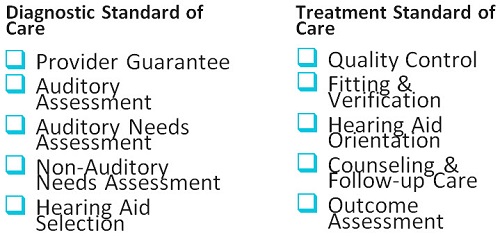
Figure 1. Diagnostic standards of care and treatment standards of care outlined in the Patient Care Excellence Program (AAA, 2006).
Let me describe each of these for you in a little bit of detail. First of all, under the diagnostic care strategy, you can see the provider guarantee. The provider guarantee is that the practice agrees that their patients will receive care directly from a licensed audiologist or will have their care supervised or overseen by a licensed audiologist.
Auditory assessment: the practice agrees to conduct a complete case history, ear examination, auditory assessment, quantification of hearing difficulty, to refer for medical care when that appears to be needed, and to explain the results of their diagnostic assessment to both the patient and any significant others that may be present.
Auditory needs assessment: the practice agrees to identify patient-specific communication needs and assess pretreatment communication handicap prior to treatment decision-making.
Non-auditory needs assessment: the practice agrees to determine patient motivation, dexterity, general health, occupational demands, and so on, prior to treatment decision-making.
Hearing aid selection: the practice will select hearing aids and assistive technologies based on the results of the assessment tools that we have just described.
Under treatment standard of care, first we have Quality Control (Figure 1). Quality control is assessing the devices that are being provided to the patient before they are provided to ensure their proper operation.
Fitting and verification: agreeing to verify hearing aid function on the ear using a probe microphone measurement and comparing that result to a standardized fitting target.
Hearing aid orientation: agreeing to ensure that patients obtain the desired benefit from amplification as easily and as efficiently as possible.
Counseling and follow-up care: the practice agrees to provide the patients with a comprehensive understanding of the effects of hearing impairment and to offer strategies to mitigate those effects.
Outcome Assessment: agreeing to quantify the impact that your treatment has had on the patient’s overall communication and quality-of-life improvement which would generally be done by re-administering handicap or speech-in-noise tests that were administered prior to treatment and then comparing those results.
In addition to these Patient Care Excellence elements as defined by the AAA Summary Guidelines (2006), participating AuDNet member practices who are participants in our Patient Care Excellence program will also agree to participate in our patient care audit. This will be an annual survey of patient satisfaction that will be conducted online. Patients of participating practices will receive a postcard, that we will provide you to send to those patients, that will give them a link to a survey on the Web. This would be a blind survey rather than to us who are conducting that survey. We would not have the patients’ names at any time. In addition to the patient responses that we obtain from your patients who have participated in your Patient Care Excellence experience, AuDNet is also going to send postcard survey invitations to strategically-identified, random households throughout the country. This will give us the opportunity to compare the responses that we obtain for patients who we know received the Patient Care Excellence level of care to the quality of care that is provided randomly to patients who we are not sure are getting that level of care. The survey will consist of no more than 20 questions. We are confident that this will indicate that when you receive treatment from an audiology practice that is dedicated to providing Patient Care Excellence that the level of satisfaction, benefit, and support will be significantly better. We can then use that as further information in our marketing initiatives to alert the consuming public to why it is in their best interest to seek out the care of an audiologist.
If you are interested in this Patient Care Excellence program, you can go to our AuDNet Web site, audnet.com, and click on the tab off to the left of the home page labeled Patient Care Excellence Program. Under that tab, you will find downloads for both the Patient Care Excellence Program details, as well as the application agreement to participate in the Patient Care Excellence Program.
18x18
In addition to this wonderful opportunity that Unitron has facilitated AuDNet and Unitron to provide, I would also like to alert you to one other thing that I think is important to know in considering being a member of AuDNet. As many of you are probably already aware, the Academy of Doctors of Audiology (ADA) announced in their most recent ADA convention their goal to change Title 18 of the Medicare Act by the year 2018 so that if classifies audiologists as limited license physicians. This change in classification would do three things. First of all it would, on a federal level, allow direct access for patients to audiology care. It would expand the scope of services that are covered by Medicare. Specifically, treatment services that audiologists provide would now be covered by Medicare. Third, it gives participating audiologists the opportunity to opt out of Medicare if they so choose.
Noted experts in the arena of government relations advise that any effective campaign targeting changes in law, particularly federal law, as this change in Title 18 is, must be waged on three fronts. First, you need a lobbying effort to enlist the support and votes of federal legislators. Second, you need a media and public relations initiative to garner public support for this change in law. Third, it requires a grassroots effort to mobilize the public’s support for the change in law. To wage this kind of three-front campaign, we are not only going to need to hire a lobbying expert, which ADA is already in the process of doing. That lobbying effort will need to be underwritten through political action campaign (PAC) funds, donations that you make to ADA that provide the campaign contributions needed to secure legislators agreements to support this law.
It is going to be consuming pretty much all of those donations just to build the PAC fund necessary to do this. Through the efforts of my colleague, Greg Frasier, ADA in the last few months has raised $200,000 in PAC donations. Even $200,000 pales in comparison to the $2.4 million that the American Medical Association (AMA) has raised in a similar period of time, and as a result, if it is just a PAC versus PAC campaign, we are likely not going to be as successful as we would like to be. So the media and public relations initiatives and the grassroots initiatives become an important component to achieving success, but the money will not be there through the donations. These initiatives will require massive financial support and an unprecedented strategic commitment in order to accomplish the goal of changing Title 18 by 2018.
Making a decision to become a member of AuDNet means that you acknowledge that AuDNet is planning to donate funds to this effort to underwrite hiring a media and public relations firm, a grassroots organizing firm to underwrite the costs associated with those firms developing these campaigns and to underwrite the daily, weekly, and monthly efforts to execute those campaigns. We are planning on donating as much as $50 per hearing instrument purchased by AuDNet members towards this cause. We estimate that if we had 800 audiology practices purchasing about 10 units a month (net level), that we could generate annually as much as $5 million towards underwriting these efforts. This kind of collaborative funding of a project of this magnitude is going to be essential in order for it to succeed. In addition to all of the opportunities associated with the discounts that Unitron is offering, the Patient Care Excellence additional discount, and the opportunity to showcase the value and importance of audiology care through that initiative, being a member of AuDNet is also critical to helping us achieve the goal of getting Title 18 changed by the year 2018.
With that said, I would like to turn the program back over to Brian, who will give you some information about both Unitron’s product line, as well as Unitron’s philosophy.
Brian Taylor: I want to echo what Dave said about the unique nature of this Patient Care Excellence program. With healthcare becoming more transparent, I think this is an example of how AuDNet is on the leading edge of these changes for the better for patient-care quality.
If you are very familiar with Unitron, you may not want to listen to the rest of the webinar because I am going to be going over Unitron product philosophy in a general overview, mainly for people who are not very familiar with Unitron.
Who is Unitron U.S.?
Unitron has been around for a number of years now. It is a little bit older than I am. Unitron is a Canadian company. Our worldwide headquarters are in Kitchener, Canada, which is about an hour outside of Toronto in what is called the Canadian Research Triangle. Some may be familiar with a company called Research in Motion, which is where the Blackberry was created. That is a well-known company that is within the Canadian Research Triangle. Unitron is the combination of Argosy, Lori Medical Labs, and the original Unitron company. For the last decade or so, we have been a member of the Sonova Group.
Just how large is the American operation? We are headquartered in Plymouth, Minnesota which is in the western suburbs of the twin cities. We have approximately 225 employees, with about 50 sales staff nationwide. In addition to our outstanding customer service, which we will talk about a little bit later and I think we are very well-known for, we have a very innovative shell manufacturing lab on site here. In addition to making customized in-the-ear hearing aids, we also make ear molds in this lab.
Unitron is one of the core brands within the Sonova family. As you know, the other brand is Phonak. The Sonova company is a holding company located in Switzerland. Lyric is another one of the brands. It is the extended-wear instrument that is offered by Sonova. As far as cochlear implants are concerned, Advanced Bionics is the brand there. Unitron is an independently-operated company within the Sonova family. We have our own distinct product line, our own marketing, and our own research and development (R&D), all of which is headquartered in Kitchener, outside of Toronto. Unitron’s R&D has unparalleled dedication and support. The figure of $100 million has been invested over the last several years by the Sonova group into the development of Unitron technology.
Another component of Unitron is our dedication to the support of clinical and academic research. Over the last decade or longer, we have been involved in some research products with some of the following universities: Louisiana Tech, The University of Iowa, University of Rochester, University of Toronto, The University of Western Ontario and University of Oldenburg. The University of Iowa has conducted some studies for us. The University of Western Ontario and Oldenburg, which is located in Europe, are the leading hearing aid/audiology universities that we have been partnering with for some time. I think that shows you the dedication to academic excellence in research that the Unitron brand brings to the profession.
Improving Speech Intelligibility in Noise
One of our core philosophies at Unitron is that our algorithm’s number-one aim needs to be to improve speech intelligibility performance for the hearing-instrument wearer. When our R&D team is working on a new algorithm and programming software, their number-one aim above all others is to make sure that the algorithm is doing what it says: improving speech intelligibility performance in background noise. We have a very deliberate core philosophy around how we do this, which I am going to talk about next.
What you see in Figure 2 is what we call the hearing instrument development Product Success Pyramid. This is a very deliberate strategy that our R&D team has up in Canada when we bring a new product to market. What you will notice is that the foundation of the pyramid is based exclusively on comfort. This tells us that, in order for an algorithm to be successful in the field, what happens at the base of the pyramid is an absolute necessity, and we will not bring anything to market unless we have achieved the things on the bottom or the foundation of the pyramid.
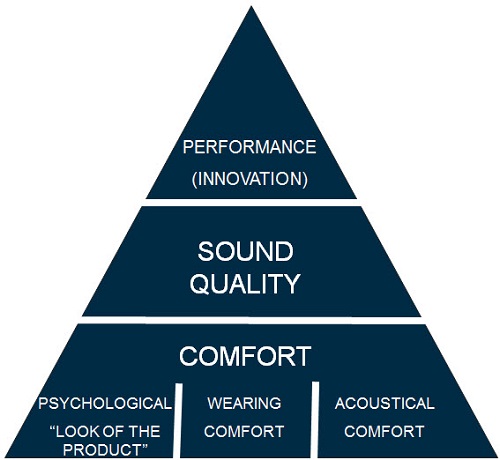
Figure 2. Unitron’s Product Success Pyramid.
You will see in Figure 2 that the foundation consists of the three modes of comfort. They have to be acoustically comfortable or acoustically transparent. There cannot be any additional distortion. It has to be a comfortable sound to the wearer. It has to be comfortable in the ear, and it has to be comfortable as far as the cosmetic appeal in appearance.
Once we get that right, then the next thing we want to make sure that we achieve is good sound quality in all situations, be it speech in noise, speech in quiet or music. We want to make sure that sound quality is as excellent as possible. Then, if and only if we have achieved those things, we can focus on what is at the top of the pyramid, which is performance in challenging situations with background noise. That is a place where I think we have brought some important innovations to the industry, and for various reasons, I think some of these have gone under the radar. I want to focus on those as we move forward.
If you dig a little deeper into this hearing instrument success pyramid, you can see where some of the products and features that we have developed and brought to market over the years fall (Figure 3). For example, when it comes to wearing comfort and the cosmetic appeal of the hearing aid, our micro CIC (completely-in-the-canal) and our Moxi, which is our receiver-in-the-canal instrument, are form factors that are very appealing and have very widespread appeal; it has been that way for a number of years.
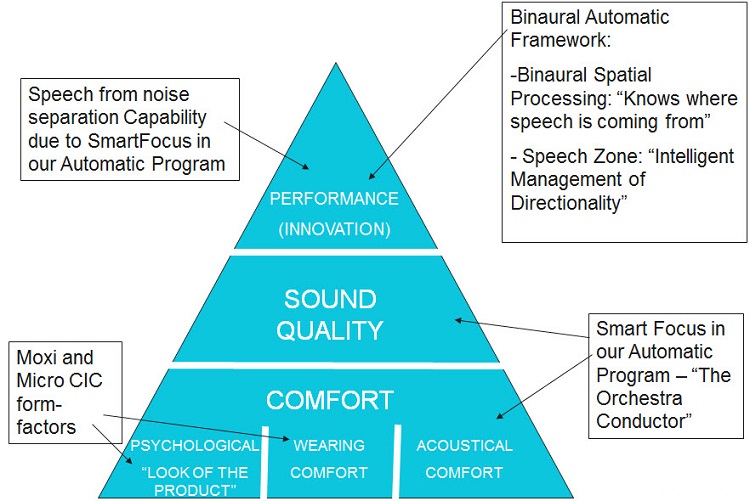
Figure 3. Breakdown of Product Success Pyramid into products and features.
When it comes to acoustical comfort and sound quality, our signature algorithm, which is called SmartFocus, is very innovative in a lot of ways. Over the last year or so, we have developed some interesting and unique algorithms around binaural spatial processing and directional microphones. That feature is called SpeechZone, and it allows your patient to optimize their ability to hear in background noise without having to use a button or a remote control. It is a completely automatic feature that optimizes directionality in both hearing instruments.
If you are into branding and marketing, you will know that the frog is our signature animal for the Moxi (Figure 4), and the butterfly is the insect of choice for Quantum (Figure 5). The only reason I bring this up is if you see some of our marketing pieces in the various trade publications or if you get one of our product launch kits, you might be wondering why you have a frog and a butterfly on there. They are simply tools that we use to market those products.

Figure 4. Unitron Moxi logo.

Figure 5. Unitron Quantum logo.
The Moxi, which has been around for a number of years now, is our receiver-in-the-canal instrument. It has been a very popular device for a long time. When you see the Moxi, you know that is our receiver-in-the-canal technology. Quantum, which is signified by the butterfly, would be all the other hearing instruments that are not receiver-in-the canal, with a few important exceptions that I will save until the end.
The Era platform is the processing platform that we put all of our hearing aids on. That is the sound processing strategy. The model of the hearing aids as I mentioned are the Moxi, which is receiver-in-the canal, and the Quantum. For each one of those, there is a breakdown of the various technology levels. If you start from the bottom, E signifies Essential. It is our economy instrument. Then as you move up the chain, you go from the E to the 6, to the 12, to the 20, and eventually to the Pro, which is our premium product line. It is a very streamlined, very straightforward set of terms that we use to describe the products.
SmartFocus
I want to spend a little bit of time going into SmartFocus, because it is our signature algorithm, and how SmartFocus works. It is unique to the industry, and there was deliberate thinking behind how this works and how it optimizes speech intelligibility in noise. SmartFocus is certainly not new. It has been about three and a half years since the signature algorithm was first launched. There have been a number of tweaks and updates to it, especially when the Era sound processing platform was launched about a year and a half ago. Let’s go into a little more detail about how SmartFocus works.
SmartFocus is a way to combine four features: the microphone directional strategy, speech enhancement, noise reduction, and overall gain. So at a very high level, those four features are tied or combined and work together on one algorithm. We call that structure SmartFocus. The aim of SmartFocus is to try to optimize speech intelligibility and overall comfort.
I would like to show you one brief schematic (Figure 6). You can see on the left-hand side of the picture what speech in noise looks like, schematically, without SmartFocus. Here you can see the speech envelope right there in front of the patient, with the patient facing upwards. The desired signal is the speech envelope. You have the on-target noise, which is signified by the triangles. That is the noise that is coming from the same direction as the speech. Then you have all this other off-target noise, represented by the circles. Without SmartFocus, everything is combined together and gets processed through the hearing aid. With SmartFocus, once the location of the speech has been recognized as coming from the front of the patient, the speech is enhanced with the spectral enhancement simultaneously, the on-target noise is reduced slightly with the noise reduction, and the off-target noise is reduced in a rather dramatic fashion with the microphone strategy. All of those things happen simultaneously with the automatic processing which is underneath the SmartFocus algorithm.

Figure 6. Comparison between speech in noise without SmartFocus (left) and with SmartFocus (right).
I can show you a different way of how SmartFocus works and the overall combined effect. If you look on this schematic (Figure 7), you see comfort on the far left and clarity on the far right. Then you see the neutral position in the middle. You can imagine the neutral position as being akin to the first-fit setting. When you enter the audiogram information into the fitting software, it gives you a first-fit starting point, and that is signified by the neutral setting. Speech is signified by the blue line and noise by the dotted black line. Along this comfort/clarity continuum, there are 20 discrete points. If the automatic processor thinks that the patient wants clarity by optimizing speech intelligibility in noise, the automatic processor deliberately enhances the speech, the relative gain, and reduces the background noise.
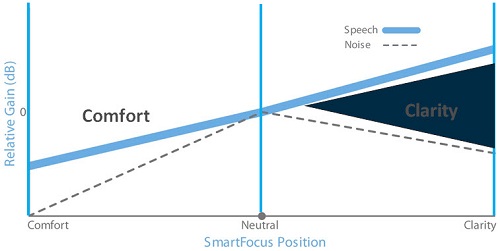
Figure 7. Overall combined effect of SmartFocus for comfort and clarity.
If the automatic processor thinks that the patient is in a situation where comfort is necessary, then the algorithm acts in a completely different way. In that situation, the relative gain is reduced significantly, the speech enhancement is off, and the noise reduction is very aggressive. So you can see that there are some pretty distinct differences depending on how the signal classification system on board the hearing aid is classifying the listening environment.
One of the important points that I would like to make right now is that SmartFocus works in the automatic program. As I mentioned, if the signal classification system on the hearing aid thinks that the patient wants optimal speech intelligibility in noise, then those four features on SmartFocus act in a very specific way. If the signal classification system thinks the patient is in a situation where comfort needs to be optimized, then those four features work in a completely different way, and that is all done automatically.
There is a manual adjustment to SmartFocus with a remote control or with a manual wheel or lever on the hearing aid, if that is needed or wanted by the patient. What we have found in our research and through about three and a half or four years of work with patients is that in a significant amount of situations, patients do just fine both from an intelligibility and sound-quality standpoint when they let SmartFocus work exclusively in the automatic program.
Another thing that I want to mention and this comes from a lot of the research that we have done over the last many years with SmartFocus is that in addition to optimizing speech intelligibility in noise, one of the consistent feedback points that we get from audiologists is that their patients are saying that the hearing aid sounds very natural. To me, that means we have accomplished our goal on the pyramid of maintaining good natural sound quality even with all of these extra algorithms working, and it also shows that patients are wearing their hearing aids and having a lot of success even in very noisy situations. I like to be boastful about the fact that we have a very natural sounding algorithm here that is reported both from audiologists and from patients.
Another way to think about SmartFocus is that the algorithm itself, the signal classifier, is the orchestra conductor, and all of those individual features (gain, microphone strategy, spectral enhancement, and noise reduction) are components or players in the orchestra. The conductor, or SmartFocus, is orchestrating how each one of those four features is going to be optimized for the patient. I think this is probably the best metaphor to explain how SmartFocus works.
Let’s compare and contrast how SmartFocus works, relative to a more traditional approach to trying to improve speech intelligibility in noise. What virtually every other manufacturer does is what I would call an independent approach of trying to optimize speech intelligibility in noise. As everyone knows, each manufacturer is trying to optimize speech intelligibility in noise. That is no secret. But what makes Unitron unique and different is what we are spending a little time on.
In a traditional approach to trying to optimize speech intelligibility in noise, these four features that I have been referring to (directionality, speech enhancement, noise cancellation and gain) are all acting independent of one another. They are all being adjusted independent of what the other one might be doing. What that means is that the chances of having an error or permutation that causes some distortion or poor sound quality is greatly enhanced, when those four features are working independently of one another. I call this the silo effect. They are all working and changing based on what the signal classifier is telling them, but they do not know what the other ones are doing. Sometimes that can be fine, but in other cases where you have a permutation or a combination of effects that are not quite right, the end result is very poor sound quality in certain situations where the patient may be spending some time. Of course we do not want any permutations. We do not want any distortions in sound quality regardless of the situation.
What makes SmartFocus unique is what we call a systems approach. As I have already mentioned, those four features have been optimized along a 20-point continuum. So rather than each one being an individual silo, they are all working harmoniously together, and they all change at the same time (Figure 8). They have been optimized to be working together along 20 points. We call it a perceptual continuum.

Figure 8. SmartFocus systems approach, where all four features work together instead of independently.
For example, if I am on the far left of the continuum (Figure 9), where the signal classifier is telling the hearing aid that this patient probably wants optimal comfort, those four features are all going to be working together and are going to change at the same time to optimize comfort. On the other end of the spectrum, if the signal classification system is saying the patient wants to optimize clarity, those four features are designed to work together to do that. They are not working independent of one another. As I mentioned before, that is all happening simultaneously, without any manual adjustment from the patient. It is all done automatically by the hearing aid, which provides a tangible benefit for many of our patients who do not want to mess around with buttons and remote controls.
The SmartFocus algorithm, again, has been around now for almost four years, but there have been some enhancements added to it rather recently. About a year ago, we introduced a new premium product line, both in the Quantum and the Moxi models. We like to say that this is taking the automatic program to a new level. What do I mean by that? There is a wireless binaural linkage between the two hearing aids. The two hearing aids communicate with that wireless binaural linkage. That means that you can get even better optimization of directionality.
SpeechZone
So the new innovation in the Pro series is something that we call SpeechZone. SpeechZone is nothing more than an enhancement to the SmartFocus algorithm. The enhancement comes from the binaural linkage of the directional feature on both hearing aids. So the binaural classification system optimizes the directionality of both hearing aids. If both hearing aids recognize that there is speech coming from the front embedded in background noise, the classifier on the hearing aid narrows the beam of the directional microphones. That happens in both hearing aids virtually simultaneously. Figure 9 shows what happens with the SmartFocus continuum when this scenario is identified.
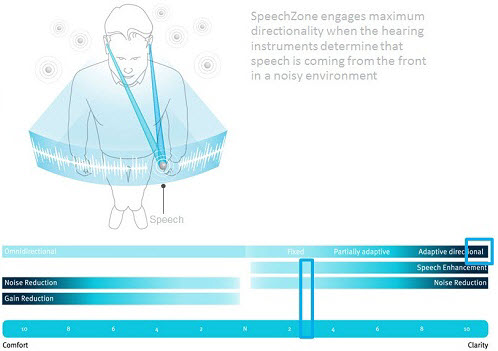
Figure 9. SpeechZone engages maximum directionality in both hearing instruments when the hearing instruments determine that speech is coming from the front in a noisy environment.
If the speech moves away from the front to the side, the beam will move with it (Figure 10). That is done automatically without any thought from the patient as to what they need to control on the hearing aid.
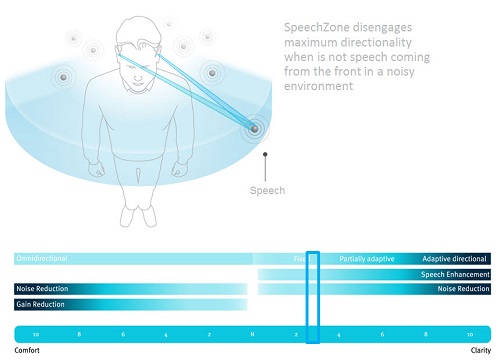
Figure 10. SpeechZone disengages maximum directionality when speech is not coming from the front in a noisy environment, thus improving the ability to hear from the sides, also.
Let me briefly go through some of the commonly asked questions about SpeechZone. We have had some phenomenal success with this algorithm over the last year. We have had not only great audiology feedback, but great patient feedback regarding sound quality, improved speech intelligibility in noise, and overall convenience of an automatic feature. There are a few things to remember about SpeechZone. Both instruments have to classify that there is speech in noise in the environment. That has to happen before SpeechZone is engaged. Next, the binaural spatial processing has to determine that speech is coming from the front, as I have already mentioned. The SmartFocus feature itself has to be at a +3 rating for clarity or higher on the continuum (Figure 10).
As I have already mentioned, SpeechZone is only available in the premium Pro, both in the Moxi and the Quantum lines. For obvious reasons, SpeechZone requires a binaural fitting, because at the heart of this algorithm is the binaural communication between the two devices. Therefore, it does not make a lot sense to have SpeechZone in a monaural fitting. The feature is available in the automatic program, and it only engages in the speech-in-noise environment. That is the default. One of the common questions that I get is, “Well isn’t SpeechZone not on very much?” In some cases it is not on very much, but it may be on in situations that are very important to the patient, which may be places where optimal speech intelligibility in noise is required. The good thing about it not being on all the time is that it does reduce battery life when employed. Unlike a lot of other binaural processing algorithms that are on the market which are on continuously, SpeechZone is only on when you need it, and that saves the patient the hassle of having to change the battery more often than usual.
Products and Features
The premium product is called Pro. Some of the features include SpeechZone, SmartFocus, self learning, binaural phone, anti-shock, and Pinna Effect, which helps with front-to-back localization and is done automatically. Binaural phone is a feature that I think has gone under the radar in a lot of cases. That allows the patient to hear through both hearing aids when the phone is held up to one ear. Another cool feature that is very useful for clinicians and patients alike is the automatic adaptation manager. That allows you to fit below the target to maximize comfort initially with the patient, and then over time, the gain of the hearing aid will seamlessly and automatically move up to the prescriptive target that is needed to optimize audibility and intelligibility. That feature is available in the Pro, as well as some of the other products that I will outline next. There is a list of accessories that we will not get into today, like the UTV and Udirect. We have a new companion microphone available that allows patients to lower the signal-to-noise ratio in a wireless way with a companion microphone. On this slide (Figure 11), you see the different channels and bands for the various products: Quantum 6, Quantum 12, and Quantum 20.

Figure 11. Features of the Quantum and Moxi 20, 12 and 6.
Another unique feature that I want to spend a minute or so on is a feature that I used to use all the time, especially with experienced users. You are able to easily change the processing strategy in the software from wide-dynamic-range compression (WDRC), which is pretty much available across the board from all manufacturers, to linear processing. That comes into play with patients that have a more significant hearing loss who are long-time users that might prefer linear processing. I have also found, and there is some literature to support this, that patients who have some auditory memory problems and are advancing in years benefit from a hearing aid that has a longer release time. Even though you are not able to change the release time on WDRC, you could simply switch them to linear processing and turn off the release time completely. If you have read the literature and you are concerned about patients that have auditory memory issues and you think they might benefit from longer release times, why not just simply give them linear processing and get rid of that as part of the fitting completely? Having linear processing available is a good thing and a nice option to have in your tool box.
You also see some of the differentiators here with the automatic destinations with SmartFocus. You will notice as you move up the product categories, that you go from automatic in only two destinations to automatic in four. There are some benefits to that. You will also notice that you cannot get Pinna Effect outside of the 20, which helps with localization. You will also notice LearnNow, which is our trainable feature, is only available in the 20. LearnNow allows the patient to train the hearing aid at a faster pace. You will also notice that binaural phone is only available in the 20 and 12, but not the 6. This is a nice outline of what features you get at each product level. I would encourage you to talk with your individual Unitron account representative if you need more details on the ins and outs of all these features.
At the economy level, because there are so many features for the categorization of the product, we have our E, which stands for essential (Figure 12). This is a six-channel hearing aid that has both WDRC and linear processing, if you want to adjust to that in rare cases as I have already mentioned. It also has the SmartFocus and the automatic adaptation manager, natural sound balance, which I did not talk about but is a way to automatically eliminate the possibility of resonance from venting. This is relatively common with some open fits where you might get a resonant peak around 500 or 700 Hz, and the hearing aid recognizes that it is a resonance and it will go in and automatically cancel it out. The one thing that the E does not have is any of the wireless or automatic features. It is a very manual hearing aid. It does have adaptive directional microphones. It has feedback management. It has a music program. The real challenge is that this is a feature-rich hearing aid at a relatively low price point, and sometimes I think it is a challenge to find reasons to move people up when this hearing aid is so good at the lower end of the product spectrum.

Figure 12. E product features.
Power Solutions
Max, our new power product, was launched a few months back and was obviously designed for severe to profound hearing loss. It comes in two different varieties, the Max 20 and the Max 6, signified by the number of the channels.
The performance profile for Max is shown in Figure 13. Max has automatic programs. You can see it goes from two programs in the 6 to four programs in the 20. It has a few unique features that I want to spend some time talking about. In addition to all the other things like SmartFocus, which has been specially designed for a power user, it has a slightly different iteration of the algorithm and binaural phone in the 20. There are a couple of signature features that are unique to this product within our line, and at least one is unique to the industry as well.
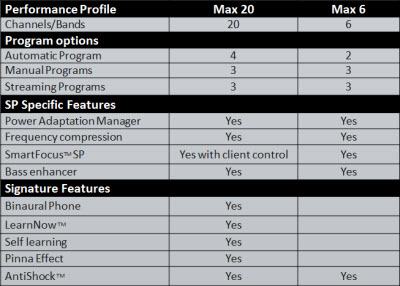
Figure 13. Max product features.
One feature that is totally unique to the industry that I know of is something called Power Adaptation Manager. A few minutes ago I talked about the automatic adaptation manager, which allows you to set the hearing aid well below the prescribed fitting target to optimize overall comfort, and then over time the hearing aid automatically and seamlessly optimizes audibility and closely matches your favorite prescriptive target. What is different here is that this feature is the reverse of that, called the Power Adaptation Manager. As we all know, a lot of experienced patients with severe to profound hearing loss are what we call “power junkies,” and they want to be fit well above the prescribed target. The danger there is that you might be over-amplifying someone and causing additional hearing loss, which is a serious problem. The power adaptation manager allows you to fit well above the prescribed target to meet the demands of the experienced user from a comfort standpoint, and then over time automatically and seamlessly move them down to a power level that still optimizes audibility, but is less likely to cause additional long-term damage to the cochlea. That is the power adaptation manager in a nutshell. It is a unique application inside of a power product.
The other feature that we have now is frequency compression. I think a lot of you have probably learned to fall in love with frequency compression. Our philosophy is that frequency compression is a viable feature and needed for severe to profound hearing loss. But for other types of hearing loss, we know that frequency compression may cause some additional distortion. The downside to frequency compression in products other than power products is that it has a possible effect of causing distortion. We know with severe or profound hearing losses, frequency compression is probably a good thing, and therefore we added it to our product line for the 20, 6, and E Max line. Max is available in both a Super Power and Super Power mini style. The Super Power takes a 675 battery and the Super Power mini takes a 13 battery.
Conclusion
I tried to go into a fairly detailed description of SmartFocus, because I think that is an incredibly innovative feature that, for various reasons, has fallen off the radar in the industry. We have had phenomenal success with it. It has been proven to work in independent academic studies, and that is something, as a Unitron employee, that I am proud to talk about. I think it is unique to the industry.
For additional information, I would encourage you to call 800-888-8882. If you do not know who your account executive is out in the field or your account rep within our building, I would encourage you to experience our first-class customer service and call. If you call that number and state your location, they will tell you who your representative is. If you have additional questions, feel free to e-mail me (brian.taylor@unitron.com) or call me at 763-744-3395. I would like to thank Dave and AuDNet for partnering with Unitron. I think there are some exciting opportunities out there. We are on the leading edge of incentivizing audiologists to maintain and enhance high clinical standards.
References
American Academy of Audiology. (2006). Audiologic management of adult hearing impairment – Summary Guidelines. Audiology Today, 18 (5), 33- 36.
Cite this content as:
Taylor, B. & Smriga, D. (2013, March). Collaborative corporate initiatives that drive consumers to audiology care. AudiologyOnline, Article #11671. Retrieved from: https://www.audiologyonline.com/


